Papers by Janice Longstreth

Springer eBooks, 1983
This report presents efforts to develop a quantitative risk assessment for 2,3,7,8-tetrachlorodiz... more This report presents efforts to develop a quantitative risk assessment for 2,3,7,8-tetrachlorodizenzo-p-dioxin (TCDD), a contaminant of phenoxyherbicides such as 2,4,5-T and silvex. Based on the available exposure information and assuming a contamination level of 0.01 ppm TCDD in silvex and 2,4,5-T, it is estimated that the general population may be exposed to a daily TCDD dose of about 0.007 pg/kg. Subpopulations consuming only TCDD-contaminated beef or dairy products are estimated to receive doses of 0.44 or 1.11 pg/kg/day, respectively. The doses estimated for occupational exposure range from a low of 0.001 pg/kg/day (flaggers) to a high of 2.18 pg/kg/day (rights-of-way hand applicators). Because TCDD induces tumors in rodents, high-to-low dose extrapolations using the probit, logit, Weibull, multi-hit, and multi-stage models were performed in order to determine a range of virtually safe doses (VSDs) associated with several levels of human risk. An unusual pattern of predictions resulted from these analyses, with the multistage model, normally the most conservative, being the least conservative. Based on this result and the uncertainty as to the mechanism of TCDD’s carcinogenic effect, it was concluded that the use of these models to estimate human risk is inappropriate. This conclusion, in conjunction with a lack of evidence that TCDD is a genotoxic carcinogen, led to an estimate of human risk from TCDD based on an acceptable daily intake (ADI) of 1 pg/kg/day. At the assumed level of TCDD contamination in 2,4,5-T and silvex, two populations receive estimated doses that slightly exceed this ADI and hence may be at risk: individuals eating only contaminated dairy products and pesticide applicators hand spraying rights-of-way.
Environmental Carcinogenesis Reviews, 1990
Annals of the New York Academy of Sciences, Sep 1, 1976
Springer eBooks, 1990
Stratospheric ozone depletion poses a threat to human health principally via the increase in ambi... more Stratospheric ozone depletion poses a threat to human health principally via the increase in ambient ultraviolet B (UV-B) radiation which it permits, but also potentially through a contribution to air pollution in the troposphere. UV-B has many direct impacts on the human body; most of them are undesirable but some, such as the generation of the active form of Vitamin D, are useful. It is probably a safe generalization, however, that the detrimental effects of UV-B exposures far outweigh the beneficial ones.

Medical Microbiology and Immunology, Nov 1, 1977
Murine C-type viruses are endogenous, genetically transmitted viruses, which have been etiologica... more Murine C-type viruses are endogenous, genetically transmitted viruses, which have been etiologically associated with spontaneous leukemias in strains of mice such as AKR/J [19]. Virus replication can be detected in normal and transformed mouse cells [29], or can be induced by various means [20,25,29]. In an attempt to understand the role of C-type viruses in the biology of various mouse tumors, there have been numerous attempts to characterize the cell surface expression of virus-associated antigens using syngeneic or allogeneic antisera produced by immunization with either intact virus or virusreplicating cells (Table 7). Because of the complexity of the antisera used, these experiments have generated considerable literature, much controversy, and incomprehensible nomenclature, which, in turn, have resulted in an abstract view of virus-associated cell surface antigens [2]. These studies are also complicated by the expression of viral components on the cell surface as an integral event in the virus budding. Therefore, the distinction between an integral membrane component and a virion component is difficult to assess. Several recent reports have suggested the widespread expression of oncornavirus glycoproteins in the absence of complete virus expression [6,18,27]. The conclusion that there is non-coordinate viral glycoprotein expression is probably premature. These studies failed to identify seroIogically or biochemically the cell surface antigens detected with the viral antigens. Thus, there is no information to suggest that the surface antigens detected are coded for by 'viral genes'. It is conceivable that both host and viral genes code for serologically related, but structurally distinct proteins. The data do suggest, however, that viral-like proteins are normally expressed and may be involved in cell differentiation. Moreover, the association and/or function of these virion cell surface antigens may be characterized by using anti-viral protein-specific antisera. There is a need for extensive, defined studies of the role of C-type viruses in the biology of normal as well as tumor cells of the mouse. This is especially true since it has been demonstrated recently that another consequence of spontaneous expression *Dedicated to Professor Werner Schiifer on the occasion of his 65th birthday Research sponsored by the National Cancer Institute under Contract No. NO1-CO-25423 with Litton Bionetics, Inc. 180 J.N. lhle et al. of endogenous murine C-type viruses is the natural development of a chronic immune response [5,8,13,17]. Thus, in the host there may exist both genetic and systemic modes of regulation of endogenous RNA tumor virus as well as cell surface virus expression. Within the past few years, many investigators have described the purification and serological characterization of most of the known viral proteins. The availability of these proteins and monospecific antisera has allowed a more realistic approach to the questions of the organization of the virus and expression of virion components on the cell surface of infected ceils. Materials and Methods Animals C57BL/6, C3H, BALB/c and AKR mice were used in these studies. All animals were specific pathogen-free (SPF) and were obtained from the Experimental Animal

Global warming is likely to result in a variety of environmental effects ranging from impacts on ... more Global warming is likely to result in a variety of environmental effects ranging from impacts on species diversity, changes in population size in flora and fauna, increases in sea level and possible impacts on the primary productivity of the sea. Potential impacts on human health and welfare have included possible increases in heat related mortality, changes in the distribution of disease vectors, and possible impacts on respiratory diseases including hayfever and asthma. Most of the focus thus far is on effects which are directly related to increases in temperature, e.g., heat stress or perhaps one step removed, e.g., changes in vector distribution. Some of the more severe impacts are likely to be much less direct, e.g., increases in migration due to agricultural failure following prolonged droughts. This paper discusses two possible approaches lo the study of these less-direct impacts of global warming and presents information from ongoing research using each of these approaches. 'Pacific Northwest Laboratory is operated for the Department of Energy by Battelle Memorial Institute under Contract DE-AC06-76RLO-1830. "'Primary. effects are those directly related to changes in weather, e. g., heat stress; tecondary effects are those one step removed from a direct effect, e.g., climate change results in crop failures leading to death from starvation: tertiary effects are two steps removed, e.g., climate change results in crop failures resulting in malnutrition which in turn leads to increased

As a result of increases in CO{sub 2} and other radiatively important trace gases, scientists hav... more As a result of increases in CO{sub 2} and other radiatively important trace gases, scientists have predicted increases in mean worldwide temperatures of 2--5 degrees C over the next 50 to 100 years. Such temperature increases may result in climate modifications that would in turn be associated with increases in drought and desertification and could even change the patterns of the monsoons and tropical rains, which are important to agriculture throughout the world. They predicted that the rise in sea level caused by melting and thermal expansion of glaciers and polar icecaps could flood large population centers, destroying habitation and displacing populations. This will result in approximately 50 million ``environmental refugees`` worldwide, triple the number of today. The expected shifts in precipitation are also likely to result in (1) increased runoff contaminated with pesticides, salts, garbage, sewage, and eroded soil, and (2) drought also leading to increased soil erosion and ...
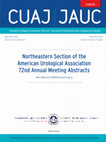
Canadian Urological Association Journal, 2020
S170 2020 has brought about a complete sea of change in how we live, socialize, operate, interact... more S170 2020 has brought about a complete sea of change in how we live, socialize, operate, interact with patients, and meet together for conferences, continuing professional development, and to catch up with colleagues from across the world. We are still grappling with COVID-19, and we will be doing so for months (if not years). As a result, the in-person meeting of the Northeastern Section of the AUA was cancelled. Instead, the Northeastern Section will be holding a free virtual 72 nd Annual Meeting on Thursday, October 1 and Saturday, October 3. Please visit nsaua.org/annual to register and for additional meeting information. Drs. Rob Hamilton and Yonah Krakowsky are our 2020 Scientific Co-chairs, and they put together an amazing program for the in-person meeting. We can't host the entire meeting online, but please join us for two three-hour sessions that will be held outside clinical hours for a compressed scientific program that includes all the "best of" our original in-person program. And despite the pandemic (or perhaps because of it!), we had a record number of abstract submissions for the meeting this year. After rigorous peer-review, we are still publishing these abstracts in this issue of CUAJ to recognize the work, effort, and science put forth by our section members, residents, and fellows. Please note that the Section will be in Montreal for our meeting in 2021 and will return to Charlotte for our 2022 meeting. For those CUAJ readers who are not aware: the NSAUA is your section for much of Canada. Canadian urologists living in all provinces from Manitoba eastwards are automatically assigned to the NSAUA when you join the AUA. So until we can meet again in person, enjoy the 2020 Annual Meeting abstracts, and be sure to register at nsaua.org/annual to attend the NSAUA Virtual 72 nd Annual Meeting the evening of Thursday, October 1 and the morning of Saturday, October 3.

Global Atmospheric Change and Public Health, 1990
Infectious diseases remain serious public health problems in the tropics and semi-tropics, which ... more Infectious diseases remain serious public health problems in the tropics and semi-tropics, which are exposed to high levels of UVB in sunlight. The UVB flux at the equator is one to four watts per square meter, so that even the highest experimentally effective doses can be acquired in several hours’ exposure to midday sun. UVB is a potent suppressor of cell-mediated immunity. Many infectious diseases are acquired via the cutaneous route and protection is mediated by cellular immunity in immunocompetent individuals. In animal models for several such infectious diseases, UVB irradiation alters pathogenesis and immunity. In a murine model for cutaneous leishmaniasis, UVB irradiation applied during the first exposure to Leishmania altered the pathology of primary skin lesions, abrogated the induction of protective immunity, and may have predisposed the mice to fatal systemic leishmaniasis. UVB irradiation of mouse skin causes a spectrum of immunological and fine structural alterations also seen in human skin. Therefore, it is likely that exposure to high levels of solar UVB may enhance severity and adversely affect protective immune responses in naturally acquired infectious diseases of humans.
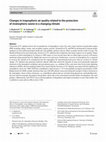
Photochemical and Photobiological Sciences, Jun 13, 2023
Ultraviolet (UV) radiation drives the net production of tropospheric ozone (O 3) and a large frac... more Ultraviolet (UV) radiation drives the net production of tropospheric ozone (O 3) and a large fraction of particulate matter (PM) including sulfate, nitrate, and secondary organic aerosols. Ground-level O 3 and PM are detrimental to human health, leading to several million premature deaths per year globally, and have adverse effects on plants and the yields of crops. The Montreal Protocol has prevented large increases in UV radiation that would have had major impacts on air quality. Future scenarios in which stratospheric O 3 returns to 1980 values or even exceeds them (the so-called super-recovery) will tend to ameliorate urban ground-level O 3 slightly but worsen it in rural areas. Furthermore, recovery of stratospheric O 3 is expected to increase the amount of O 3 transported into the troposphere by meteorological processes that are sensitive to climate change. UV radiation also generates hydroxyl radicals (OH) that control the amounts of many environmentally important chemicals in the atmosphere including some greenhouse gases, e.g., methane (CH 4), and some short-lived ozone-depleting substances (ODSs). Recent modeling studies have shown that the increases in UV radiation associated with the depletion of stratospheric ozone over 1980-2020 have contributed a small increase (~ 3%) to the globally averaged concentrations of OH. Replacements for ODSs include chemicals that react with OH radicals, hence preventing the transport of these chemicals to the stratosphere. Some of these chemicals, e.g., hydrofluorocarbons that are currently being phased out, and hydrofluoroolefins now used increasingly, decompose into products whose fate in the environment warrants further investigation. One such product, trifluoroacetic acid (TFA), has no obvious pathway of degradation and might accumulate in some water bodies, but is unlikely to cause adverse effects out to 2100. This Perspective is part of the topical collection: Environmental effects of stratospheric ozone depletion, UV radiation, and interactions with climate change: UNEP Environmental Effects Assessment Panel, 2022 Quadrennial Assessment.
Environmental Carcinogenesis Reviews, 1989
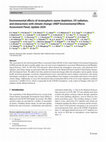
Photochemical and Photobiological Sciences, 2021
This assessment by the Environmental Effects Assessment Panel (EEAP) of the United Nations Enviro... more This assessment by the Environmental Effects Assessment Panel (EEAP) of the United Nations Environment Programme (UNEP) provides the latest scientific update since our most recent comprehensive assessment (Photochemical and Photobiological Sciences, 2019, 18, 595-828). The interactive effects between the stratospheric ozone layer, solar ultraviolet (UV) radiation, and climate change are presented within the framework of the Montreal Protocol and the United Nations Sustainable Development Goals. We address how these global environmental changes affect the atmosphere and air quality; human health; terrestrial and aquatic ecosystems; biogeochemical cycles; and materials used in outdoor construction, solar energy technologies, and fabrics. In many cases, there is a growing influence from changes in seasonality and extreme events due to climate change. Additionally, we assess the transmission and environmental effects of the severe acute respiratory syndrome coronavirus 2 (SARS-CoV-2), which is responsible for the COVID-19 pandemic, in the context of linkages with solar UV radiation and the Montreal Protocol.
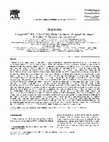
Journal of Photochemistry and Photobiology B-biology, Oct 1, 1998
The health risks associated with ozone depletion will principally be those due to increased ultra... more The health risks associated with ozone depletion will principally be those due to increased ultraviolet B (UV-B) radiation in the environment, i.e., increased damage to the eyes, the immune system, and the skin. Some new risks may also be introduced with the increased use of alternatives to the ozone-depleting substances (ODSs). Quantitative risk estimates are available for some of the UV-B-associated effects, e.g., cataract and skin cancer; however, the data are insufficient to develop similar estimates for effects such as immunosuppression and the toxicity of alternatives. Ocular damage from UV exposures includes effects on the cornea, lens, iris, and associated epithelial and conjunctival tissues. The most common acute ocular effect of environmental ultraviolet radiation (UVR) is photokeratitis. Also known as snowblindness in skiers, this condition also occurs in other outdoor recreationists. Chronic eye conditions likely to increase with ozone depletion include cataract, squamous cell carcinoma, ocular melanoma, and a variety of comeal/conjunctival effects, e.g., pterygium andpinguecula. Suppression of local (at the site of UV exposure) and systemic (at a distant, unexposed site) immune responses to a variety of antigens has been demonstrated in both humans and animals exposed to UV-B. In experiments with animals these effects have been shown to worsen the course/ outcome of some infectious diseases and cancers. There is reasonably good evidence that such immunosuppression plays a role in human carcinogenesis; however, the implications of such immunosuppression for human infectious diseases are still unknown. In light-skinned populations, exposure to solar UVR appears to be the most important environmental risk factor for basal and squamous cell carcinomas and cutaneous melanoma. Originally it was believed that total accumulated exposure to UVR was the most important environmental factor in determining risk for these tumors. Recent information now suggests that only squamous cell carcinoma risk is related to total exposure. In the cases of both basal cell carcinoma and melanoma, new information suggests that increases in risk are tied to early exposures (before about age 15), particularly those leading to severe sunburns. Testing of a number of the chlorofluorocarbon (CFC) alternatives indicates that most of these chemicals have low acute toxicity, and low to moderate chronic toxicity. Some chemicals that were originally proposed as alternatives have been dropped from consideration because these tests raised concerns about toxicity and/or manufacturing difficulties. In one instance, high accidental occupational exposure was associated with liver damage, underlining the need for care in the use of these substitutes. Recent quantitative risk estimates have been developed for cataract, melanoma, and all skin cancers combined. These estimates indicate that under the Montreal Adjustments, cataract and skin-cancer incidence will peak mid-century at additional incidences of just under 3 per 100 000 and about 7 per 100 000, respectively.
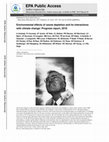
Photochemical and Photobiological Sciences, Mar 1, 2010
Dedication This Progress Report is dedicated to the memory of Professor Jan van der Leun, foundin... more Dedication This Progress Report is dedicated to the memory of Professor Jan van der Leun, founding co-chair in 1987, member of the UNEP Environmental Effects Assessment Panel (EEAP), and contributor to the section on human health. In 1971, through attending a dedicated meeting of the National Academy of Sciences, Jan became involved in assessing the impact of a looming threat of a thinning ozone layer. He quantified the effect on skin cancer, became a renowned expert on the subject and conducted important research on the dose-effect in UV carcinogenesis to improve his assessments. We will remember Jan for his untiring dedication also to other health impacts, focussing on the interactions with climate change, and in presenting the broad scientific basis for protecting the stratospheric ozone layer. For the EEAP his enduring legacy lies in the remarkable contribution he made in communicating the importance to policymakers, scientists and the public, of phasing out the substances that were depleting the ozone layer and consequently leading to increasing UV radiation. He indeed had a particular talent for emphasising and linking the scientific and political implications of protecting the ozone layer. He has left lasting and warm memories of his presence and leadership; we will keep these memories of a collegial diplomat and personal friend as we carry on his good work.
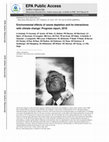
Photochemical and Photobiological Sciences, 2012
Dedication This Progress Report is dedicated to the memory of Professor Jan van der Leun, foundin... more Dedication This Progress Report is dedicated to the memory of Professor Jan van der Leun, founding co-chair in 1987, member of the UNEP Environmental Effects Assessment Panel (EEAP), and contributor to the section on human health. In 1971, through attending a dedicated meeting of the National Academy of Sciences, Jan became involved in assessing the impact of a looming threat of a thinning ozone layer. He quantified the effect on skin cancer, became a renowned expert on the subject and conducted important research on the dose-effect in UV carcinogenesis to improve his assessments. We will remember Jan for his untiring dedication also to other health impacts, focussing on the interactions with climate change, and in presenting the broad scientific basis for protecting the stratospheric ozone layer. For the EEAP his enduring legacy lies in the remarkable contribution he made in communicating the importance to policymakers, scientists and the public, of phasing out the substances that were depleting the ozone layer and consequently leading to increasing UV radiation. He indeed had a particular talent for emphasising and linking the scientific and political implications of protecting the ozone layer. He has left lasting and warm memories of his presence and leadership; we will keep these memories of a collegial diplomat and personal friend as we carry on his good work.
Environment International, 1991
Photochemical and Photobiological Sciences, 2003
This quadrennial Assessment was prepared by the Environmental Effects Assessment Panel (EEAP) for... more This quadrennial Assessment was prepared by the Environmental Effects Assessment Panel (EEAP) for the Parties to the Montreal Protocol. The Assessment reports on key findings on environment and health since the last full Assessment of 2006, paying attention to the interactions between ozone depletion and climate change. Simultaneous publication of the Assessment in the scientific literature aims to inform the scientific community how their data, modeling and interpretations are playing a role in information dissemination to the Parties to the Montreal Protocol, other policymakers and scientists.
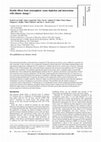
Photochemical and Photobiological Sciences, 2003
First published as an Advance Article The potential health effects of elevated levels of ambient ... more First published as an Advance Article The potential health effects of elevated levels of ambient UV-B radiation are diverse, and it is difficult to quantify the risks, especially as they are likely to be considerably modified by human behaviour. Nevertheless epidemiological and experimental studies have confirmed that UV radiation is a definite risk factor for certain types of cataract, with peak efficacy in the UV-B waveband. The causal link between squamous cell carcinoma and cumulative solar UV exposure has been well established. New findings regarding the genetic basis of skin cancer, including studies on genetically modified mice, have confirmed the epidemiological evidence that UV radiation contributes to the formation of basal cell carcinomas and cutaneous melanomas. For the latter, animal models have demonstrated that UV exposure at a very young age is more detrimental than exposure in adulthood. Although suppression of certain immune responses has been recognised following UV exposure, the impact of this suppression on the control of infectious and autoimmune diseases is largely unknown. However, studies on several microbial infections have indicated significant consequences in terms of symptoms or reactivation of disease. The possibility that the immune response to vaccination could be depressed by UV-B exposure is of considerable concern. Newly emerging possibilities regarding interactions between ozone depletion and global climate change further complicate the risk assessments for human health but might result in an increased incidence of cataracts and skin cancer, plus alterations in the patterns of certain categories of infectious and other diseases. † This article is published as part of the United Nations Environmental Programme: Environmental effects of ozone depletion and its interactions with climate change: 2002 assessment.
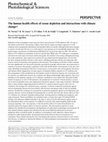
Photochemical & Photobiological Sciences, 2011
Depletion of the stratospheric ozone layer has led to increased solar UV-B radiation (280-315 nm)... more Depletion of the stratospheric ozone layer has led to increased solar UV-B radiation (280-315 nm) at the surface of the Earth. This change is likely to have had an impact on human exposure to UV-B radiation with consequential detrimental and beneficial effects on health, although behavioural changes in society over the past 60 years or so with regard to sun exposure are of considerable importance. The present report concentrates on information published since our previous report in 2007. The adverse effects of UV radiation are primarily on the eye and the skin. While solar UV radiation is a recognised risk factor for some types of cataract and for pterygium, the evidence is less strong, although increasing, for ocular melanoma, and is equivocal at present for age-related macular degeneration. For the skin, the most common harmful outcome is skin cancer, including melanoma and the non-melanoma skin cancers, basal cell carcinoma and squamous cell carcinoma. The incidence of all three of these tumours has risen significantly over the past five decades, particularly in people with fair skin, and is projected to continue to increase, thus posing a significant worldwide health burden. Overexposure to the sun is the major identified environmental risk factor in skin cancer, in association with various genetic risk factors and immune effects. Suppression of some aspects of immunity follows exposure to UV radiation and the consequences of this modulation for the immune control of infectious diseases, for vaccination and for tumours, are additional concerns. In a common sun allergy (polymorphic light eruption), there is an imbalance in the immune response to UV radiation, resulting in a sun-evoked rash. The major health benefit of exposure to solar UV-B radiation is the production of vitamin D. Vitamin D plays a crucial role in bone metabolism and is also implicated in protection against a wide range of diseases. Although there is some evidence supporting protective effects for a range of internal cancers, this is not yet conclusive, but strongest for colorectal cancer, at present. A role for vitamin D in protection against several autoimmune diseases has been studied, with the most convincing results to date for multiple sclerosis. Vitamin D is starting to be assessed for its protective properties against several infectious and coronary diseases. Current methods for protecting the eye and the skin from the adverse effects of solar UV radiation are evaluated, including seeking shade, wearing protective clothing and sunglasses, and using sunscreens. Newer possibilities are considered such as creams that repair UV-induced DNA damage, and substances applied topically to the skin or eaten in the diet that protect against some of the detrimental effects of sun exposure. It is difficult to provide easily understandable public health messages regarding "safe" sun exposure, so that the positive effects of vitamin D production are balanced against the negative effects of excessive exposure. The international response to ozone depletion has included the development and deployment of replacement technologies and chemicals. To date, limited evidence suggests that substitutes for the ozone-depleting substances do not have significant effects on human health. In addition to stratospheric ozone depletion, climate change is predicted to affect human health, and potential interactions between these two parameters are considered. These include altering the risk of developing skin tumours, infectious diseases and various skin diseases, in addition to altering the efficiency by which pathogenic microorganisms are inactivated in the environment.










Uploads
Papers by Janice Longstreth